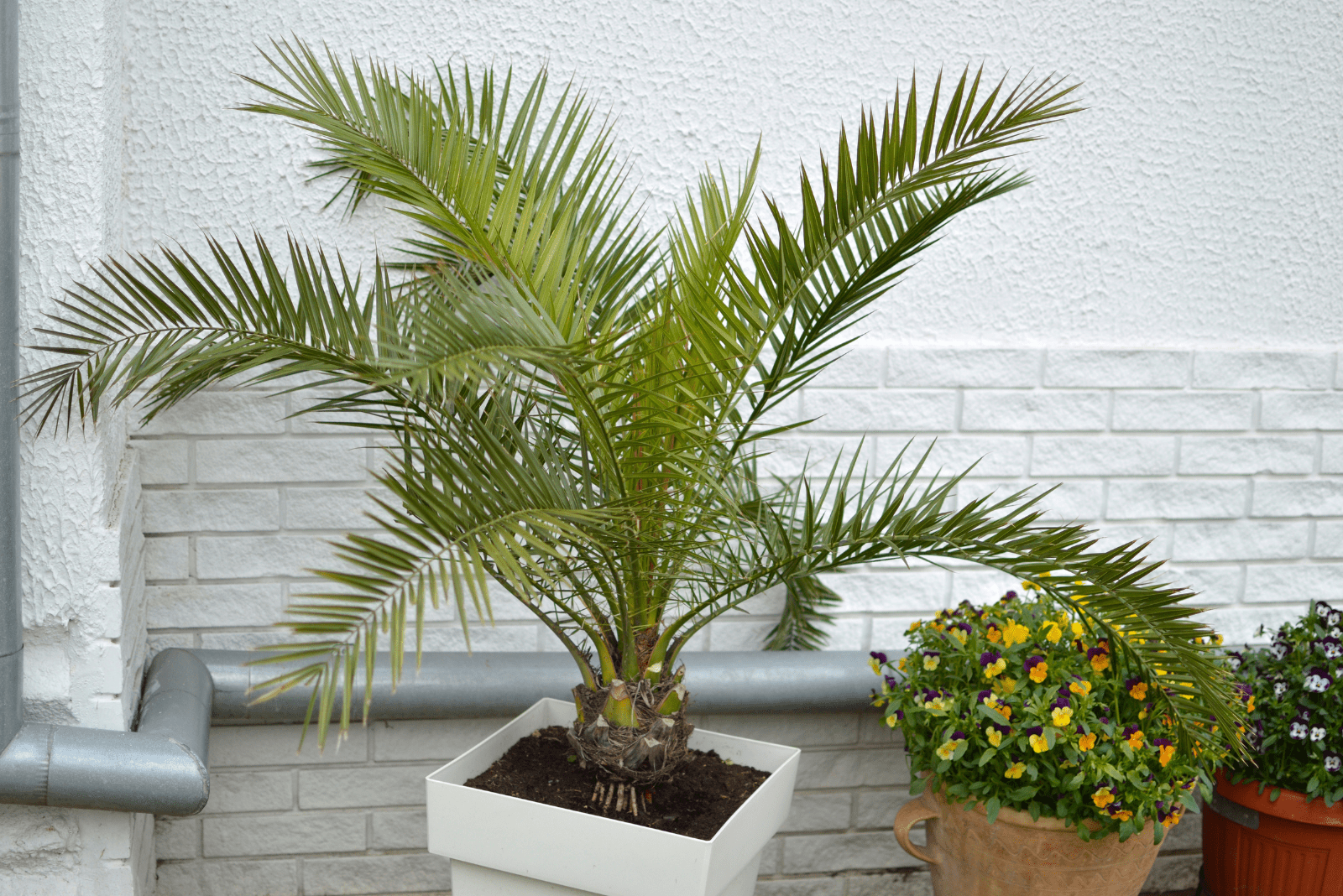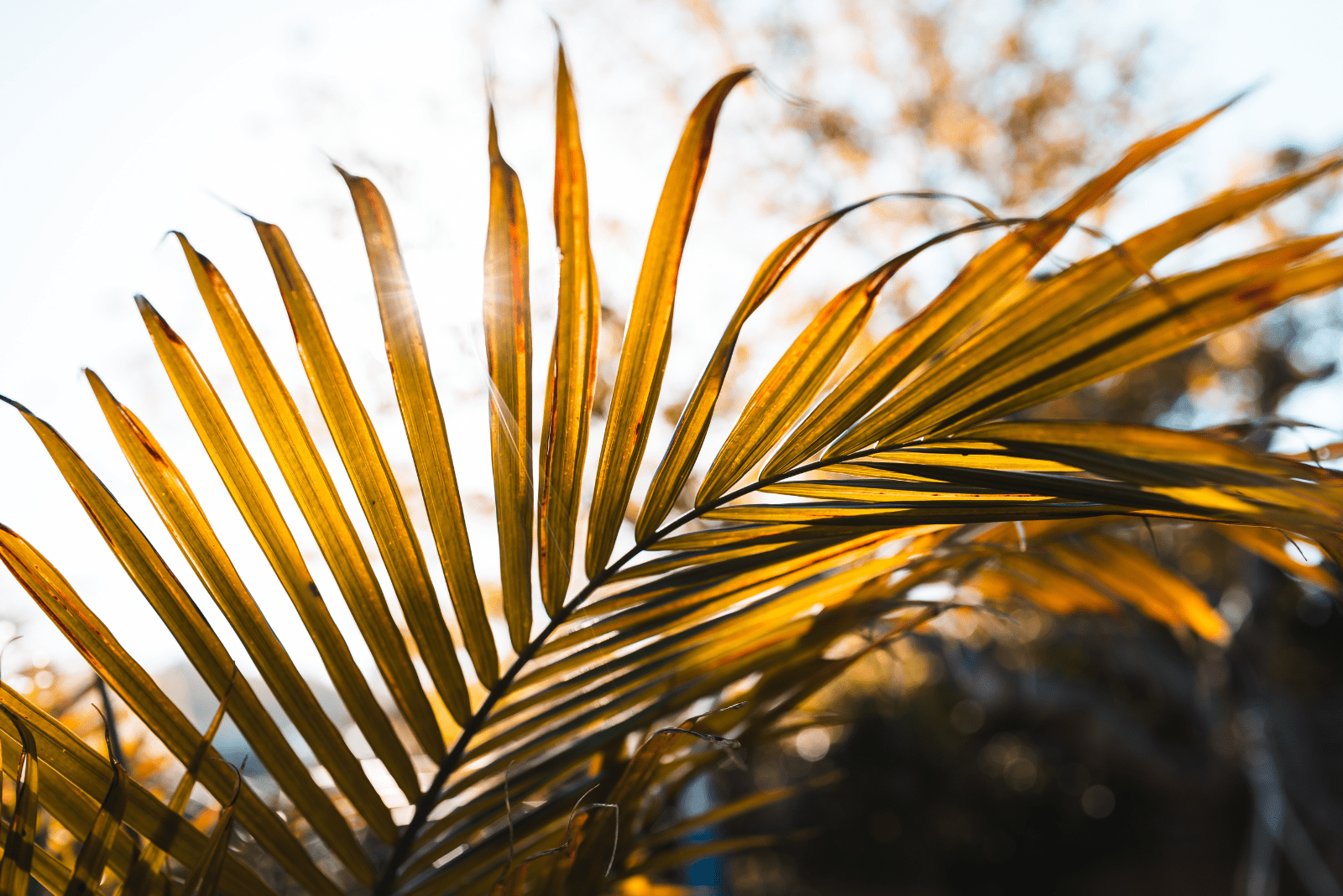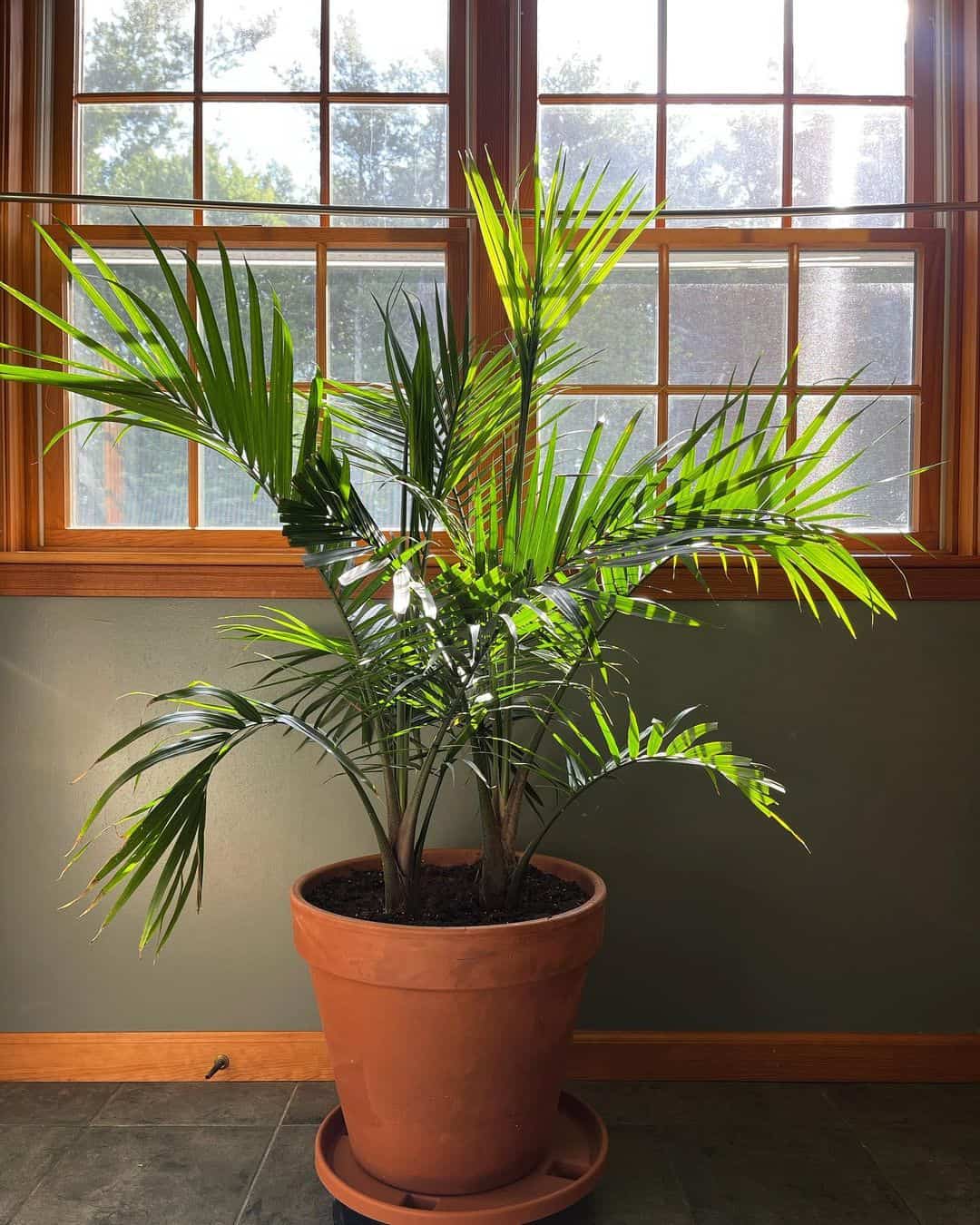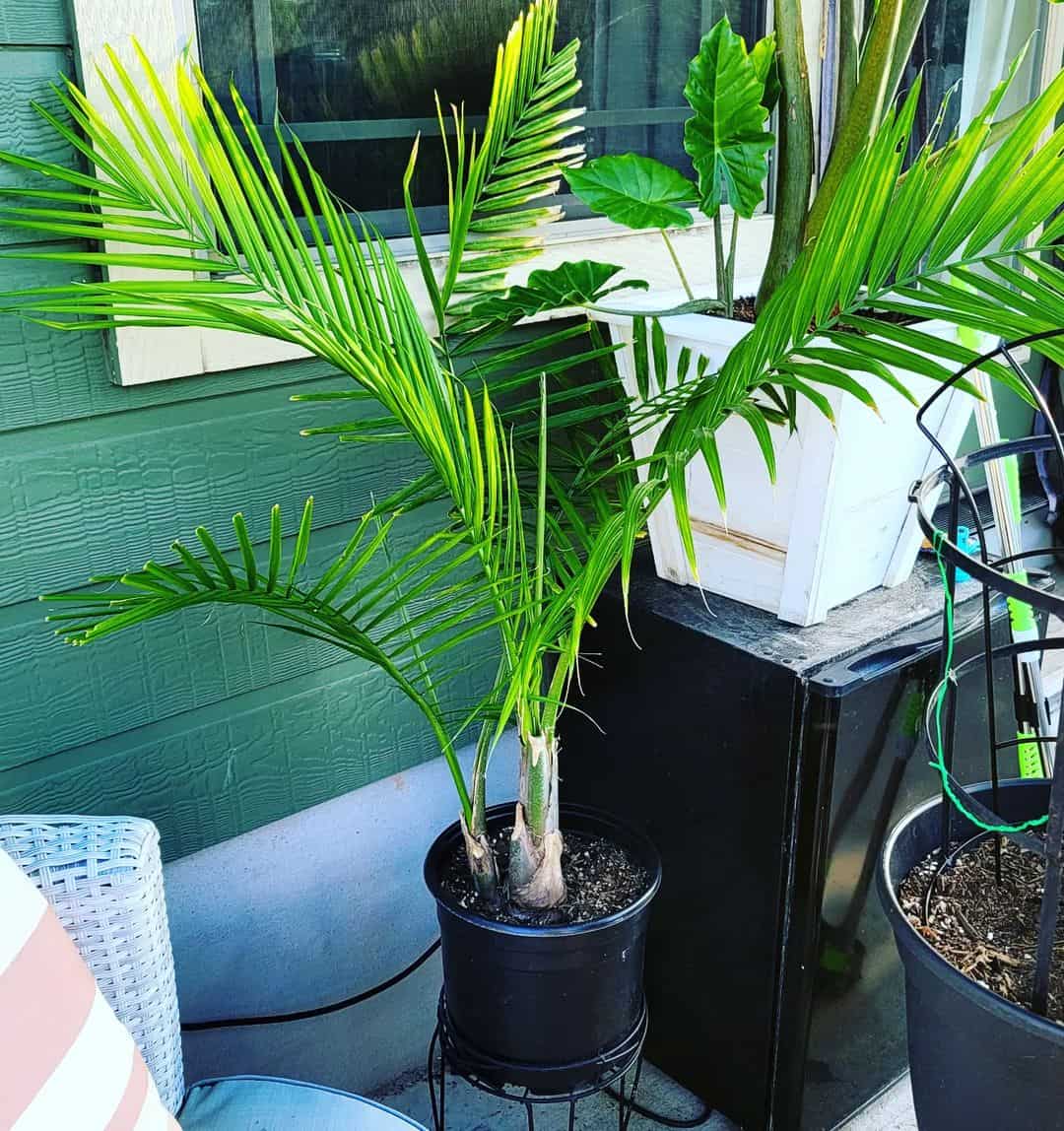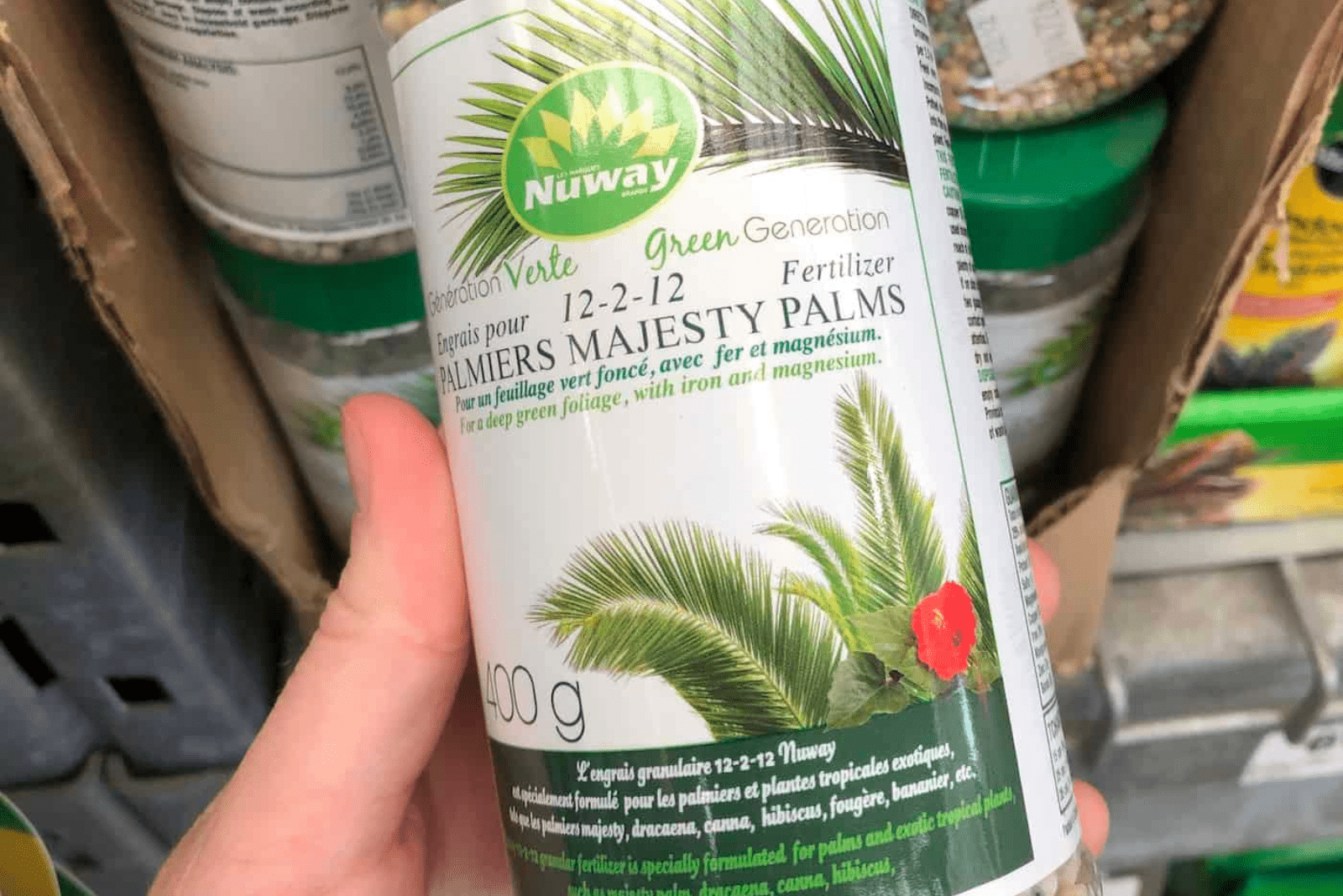Positive Bloom is an Amazon Associate and we earn from qualifying purchases through these links at no extra cost to you.
Green palm fronds can beautify any home, so it’s important to know how to take care of them.
Bright indirect light and occasional watering are a great place to start, and palm trees also require plant food from time to time. The same goes for majesty palms.
These plants need fertilizer in order to grow big and strong, so we decided to make this handy guide for their needs and present the best fertilizers to help your plant develop.
Before we delve into this subject more deeply, let’s examine some general information about majesty palm trees:
[table id=222 /]
Majesty Palm Fertilizer Needs
Yellow palm tree leaves are frequently caused by inadequate fertilization, so you should learn your plant’s preferences before feeding them.
Not all plants need fertilizers with the same NPK ratio – in fact, not all palm trees need the same fertilizer.
The ideal NPK ratio for these palms are 3-1-3 or 8-2-12, which contain micronutrients such as magnesium, manganese, and iron. You can use stronger fertilizers, but you should either dilute them or use them less frequently.
The main thing to remember about feeding majesty palms is choosing the right fertilizer, but it also depends on whether you’re growing this palm tree as an outdoor or indoor plant.
An indoor majesty palm can tolerate regular houseplant fertilizers, just make sure that the fertilizer is rich in nitrogen to promote the growth of lush, green fronds.
You should use liquid fertilizers for indoor palms as they are absorbed more quickly. However, ensure you always follow the instructions on the package and dilute to at least half-strength because they are very concentrated.
You can also use these fertilizers for outdoor majesty palm trees, but you will have to feed them more often. Therefore, slow-release fertilizers such as pellets and sticks are a great idea as they can last for at least three months before you have to reapply them.
Necessary Nutrients For Palm Trees
The most important nutrient for your majesty palm is nitrogen because it promotes lush growth.
However, it also needs fertilizer with high potassium levels as deficiency of this mineral can cause older leaves to drop, become chlorotic and frizzled, and lead to the death of the plant.
Manganese and magnesium play a major role in photosynthesis, and majesty palm care simply isn’t complete without these minerals.
Phosphorus ensures overall plant health, and encourages winter hardiness and root growth. Still, too much phosphorus will reduce the plant’s ability to absorb necessary nutrients such as zinc and iron, so use fertilizers with lower levels of this macronutrient.
6 Majesty Palm Fertilizers
Majestic palms are frequently found in Florida, and getting the right kind of fertilizer plays a significant role in their care.
Of course, getting the right potting soil for palm trees is also essential, but giving them the food they need will keep their leaves green and bushy and help them grow faster.
Thankfully, there are specialized fertilizers for palm trees you can use to speed up the slow growth of this tropical plant and prevent its leaves turning yellow.
Below you will find the six best fertilizers for the majesty palm (and palms in general) that provide the best plant care.
1. Jack’s Classic Palm Food
[lasso id=”8541″ link_id=”7574″ ref=”amzn-jr-peters-51624-jacks-classic-16-5-25-palm-food-1-5-lb”]
This fertilizer is ideal for many different palm trees, not just the majesty palm, and you can even use it to feed your hibiscuses. Its NPK ratio is 16-5-25 and it even contains some magnesium, which makes it ideal for palms.
It prevents harmful salt build-up, and all you have to do is mix some powder with water and irrigate your plants with it.
High potassium levels ensure lusher, greener, and stronger growth, so you won’t have to worry about yellowing leaves ever again.
You’ll have to wait about a month or so to see the actual difference, but it’s definitely worth it.
2. Miracle-Gro Shake ‘N Feed Palm Fertilizer
[lasso id=”8440″ link_id=”7575″ ref=”amzn-miracle-gro-shake-n-feed-palm-plant-food-8-lb-feeds-up-to-3-months”]
Miracle-gro is an ideal slow-release fertilizer for palms, cycads, and all kinds of tropical plants. It is enriched with micronutrients such as iron, magnesium, and manganese, and will prevent yellow and curly palm leaves.
It promotes lush growth, and can be used for both potted and in-ground plants.
It will feed your palm trees for up to three months without burning or overfertilizing them if you follow the instructions on the package.
It’s pretty easy to use and spread; all you have to do is sprinkle some granules onto the soil, mix it well, and water the plant afterward.
3. BGI PALMGAIN Palm Plant Food
[lasso id=”8543″ link_id=”7576″ ref=”amzn-bgi-palmgain-2lb-bag-palm-tree-fertilizer-ferns-cycads-ixora”]
This plant food is another suitable fertilizer for palm trees because it contains micronutrients such as iron, magnesium, and sulfur.
Your palms, ferns, and other tropicals will thrive with this fertilizer because slow-release nitrogen ensures a steady supply and promotes lush growth.
It even comes in a resealable bag, so you don’t have to worry about storage.
BGI PALMGAIN is a formula recommended by the University of Florida IFAS Extension. It can be used for ponytail palms – a variety that isn’t a real palm tree, but a succulent.
You can use this fertilizer for many different palms, and your research and examination of the differences and similarities between areca and parlor palm trees won’t be in vain because you can use it for them as well!
4. Jobe’s Fertilizer Spikes For Ferns And Palms
[lasso id=”8439″ link_id=”7577″ ref=”amzn-jobes-05101-fern-palm-fertilizer-spikes-30-per-blister-pack”]
Fertilizer spikes are the best option for those who tend to forget when to fertilize their plants. They are incredibly easy to use, you just have to measure the diameter of the pot and insert the number of spikes indicated on the package.
They will ensure a continuous supply of nutrients to your palm trees and keep them happy for up to three months. They’re an ideal choice for indoor plants because they don’t have an odor or leave wasteful runoff.
They pose no danger for your pets, but definitely don’t feed them with this product! They don’t make any mess either.
The package contains 30 spikes and can last for quite a while.
5. Dr. Earth Exotic Blend: Palm, Tropical, And Hibiscus Fertilizer
[lasso id=”8544″ link_id=”7578″ ref=”amzn-dr-earth-inc-756p-exotic-dr-earth-exoitc-blend-palm-tropical-hibiscus-fertilizer-4lb-natural”]
Dr. Earth exotic blend is a 100% natural formula that doesn’t contain any GMO or toxic ingredients, and is handmade with human and feed-grade components.
It is completely safe to use around pets and people, and presents an eco-friendly option for your plants.
It’s enriched with all sorts of minerals and micronutrients, humic acid, carbohydrates, and proteins, so it heals the soil and ensures the best possible growing conditions for your palm trees, hibiscus, and tropical plants.
It does emit an unpleasant smell, but that’s what you would expect from completely organic fertilizer!
6. TreeHelp Complete Palm Fertilizer Spikes
[lasso id=”8545″ link_id=”7579″ ref=”amzn-treehelp-complete-palm-fertilizer-spikes-case-of-10″]
TreeHelp fertilizer spikes are an easy way of giving your palm tree everything it needs. They are enriched with micronutrients like manganese and magnesium, and provide nutrients in a form that your plant can easily absorb.
The good news is that they last up to a year, so you can forget about the tedious task of constantly fertilizing your plants!
A great thing about these spikes is that you can use them for potted plants and newly planted and established plants alike, so you won’t have to buy several different kinds of fertilizers to meet all your majesty palm’s needs.
These spikes aren’t the easiest thing to use, though. They look like they would just slide into the ground, but they are quite fragile and may crumble while you’re attempting to insert them. However, you can simply dig a hole deep enough for the spike to fit and then cover it with soil to avoid this issue.
When To Fertilize Majesty Palms
Now that you know what the best fertilizers for majesty palms are, it’s time to learn about using them.
You cannot fertilize majesty palms (or any plant for that matter) all year round because it would lead to overfertilizing. Instead, you should only feed your palm during its growing season because that’s when it actively grows and needs more nutrients to develop.
Avoid fertilizing in winter because that’s when this plant enters dormancy, and its root system cannot absorb additional nutrients during this period.
You should fertilize your plants regularly, and if there’s a nutrient deficiency in the soil your palm tree will let you know by displaying one of the 5 signs below.
5 Signs That A Majesty Palm Needs Fertilizer
There are five common signs that your majesty palm needs more fertilizer, but these same signs can also indicate that something else is wrong with your plant.
You should always examine all the possible solutions before doing anything, and make sure you’re absolutely certain that your plant’s issue is nutrient deficiency.
1. Stunted Growth
Photo from: @kmnazi
Try to recall the last time you watered or repotted this plant before giving it more fertilizer.
Furthermore, a decrease in growth is usually caused by nitrogen deficiency, so make sure you’re using nitrogen-rich plant food.
2. Leaf Tip Drop
Leaf drop may indicate many things, one of them being nutrient deficiency. However, foliage dropping can also occur because of storms and cold weather, so always protect your outdoor palms or grow them in sheltered places (although nutrient deficiency usually manifests as the dropping of the leaf’s tip, not the entire leaf).
Manganese deficiency is responsible for leaf tip drop, but it only appears in the worst cases so you’ll have plenty of time to prevent it progressing any further.
A lack of potassium can lead to older leaves dropping, so you should check the levels of this nutrient as well.
3. Wilted Leaves
If the plant isn’t getting enough macro and micronutrients, it will become droopy. Inadequate potassium and manganese in the potting mix will lead to wilted leaves, so don’t forget to fertilize your plant!
However, wilting of majesty palm fronds can also be the result of inadequate moisture, so make sure you mist your plant frequently or invest in a humidifier.
The majesty palm needs moist soil to thrive, so check it frequently and only add more food when you’re sure that’s the only reason for your plant’s new slouchy look.
4. Brown Leaf Tips And Edges
Brown tips and edges are usually a sign that your majesty palm isn’t getting enough air moisture, but if you already live in a high humidity climate you might want to think about fertilizing your plants.
Dark spots on leaf tips and edges are actually necrotic tissue that appears due to a lack of potassium. As this issue progresses, the leaves will start to look withered and burnt.
In this case, you should add a slow-release potassium sulfate and some magnesium to counter the deficiency and ensure healthy growth.
Unfortunately, discolored and necrotic leaves cannot regain their attractive looks, so you’ll have to prune them once the plant gets stronger.
5. Yellow And Faded Foliage
Your palm’s leaves may turn yellow if it doesn’t get enough nitrogen, iron, magnesium, or manganese, so use fertilizers that contain all these nutrients.
Manganese deficiency will first appear as a chlorosis (sporadic yellowing between foliage veins). If you don’t deal with this problem in its early stages, the leaves will shrink and appear withered, burnt, and frizzled.
Iron and magnesium deficiencies aren’t as damaging as the others, and your palm tree will most likely survive them, however, yellow chlorosis between the veins isn’t a pleasant sight at all!
Magnesium deficiency is usually accompanied by potassium deficiency, which is deadly, so you should replenish these nutrients at once.
Of course, faded and yellow leaves may also appear due to a number of things like low-light levels and over or underwatering, so always examine your plant to determine the causes of discoloration.
The signs of overwatered palm trees are similar to those of nutrient deficiency, but they’re not to be trifled with, so give your plant a helping hand as soon as you notice something isn’t right.
How To Fertilize Majesty Palms
Photo from: @miss.planty.pants
Majesty palms are riverbank plants that need plenty of nutrients to sustain their growth. However, you should always follow the instructions on the package if you want to avoid additional problems.
The key thing is to feed this plant during its growing season when it can use all the nutrients you give it. Fertilize it in spring and summer with a liquid fertilizer, slow-release plant food, or spikes.
Choose the variety that suits your needs and routine so you don’t have to make too many adjustments.
If you’re using granular fertilizer or spikes, make sure to water your palm thoroughly after applying them to the soil as this will make them available to the plant’s roots.
It’s essential to prevent splashing the fertilizer onto your plant’s foliage to avoid severe burns. You’ll have to prune the damaged leaves if this does happen.
Lastly, indoor plants may need more frequent fertilization as they drain faster. You may even have to feed them once a month (or more often).
Organic Fertilizers For Majesty Palms
A mixture of organic compost is the ideal non-chemical option for majesty palms.
Seaweed and bone meal are also quite effective. However, they both contain low amounts of nitrogen so you should include some other fertilizers like blood, fish, or feather meal.
Magnesium and iron powder are sometimes included in homemade natural fertilizers for royal palms simply because they replenish the necessary micronutrients and keep plants vigorous and green.
Effects Of Overfertilization
Majesty palms are low-maintenance plants and they need very little to be happy, so we tend to overfertilize them.
Too much plant food is never good, and it can lead to discoloration of the foliage and chemical burns to your plant’s root system. Overfertilized plants will lose their ability to absorb nutrients and water, which will only lead to unhealthy palm trees.
However, if the roots aren’t damaged yet, your plant may start growing rapidly and become too heavy for the roots.
There’s a study depicting a relationship between fertilizers and pests, and it clearly links higher nitrogen levels in plant tissue to more frequent pest infestations. So far, it’s been noted that spider mites and aphids attack plants that have too much nitrogen in their flesh.
Make sure that you don’t fertilize your plants too often, and that you use fertilizers specially made for palm trees to keep its pest resistance high.
FAQ
We have discussed some of the main issues concerning majesty plant fertilizer requirements, but there’s more!
We found some of your frequently asked questions, and we will answer them to clear up some common misconceptions.
Let’s get started!
Can you use lawn fertilizer for a majesty palm?
You shouldn’t use lawn fertilizers for palm trees because they contain inadequate amounts of nitrogen and potassium, which may hurt your plant.
Also, they don’t contain enough magnesium, or they don’t have it at all, which would hinder your palm’s ability to photosynthesize.
On the other hand, you can use palm tree fertilizer to feed grasses and make your lawn green and thick in no time.
Is palm tree fertilizer safe to use on a potted palm tree?
Yes, you can use palm tree fertilizers for potted palms; just make sure you’re using the right one.
There are fertilizers made explicitly for indoor plants (and potted ones), so use them instead of experimenting with outdoor ones.
How fast does a majesty palm grow?
Majesty palms are considered fast growers because they grow approximately one foot a year. They reach their mature height in about ten years, but it largely depends on the environment.
This variety grows a bit slower indoors, and it definitely doesn’t reach 10 feet, which is a good thing because many of us don’t live in mansions that can fit this monster in!
They grow up to 5 feet tall, but it’ll take them at least five years to get there.
To Sum Up
This article examined all the basic majesty palm fertilizer needs, such as how and when to fertilize them.
We also included some of the most common signs of under and overfertilization, which can serve as a friendly reminder to avoid them both!
Most importantly, we presented some of the best fertilizers for these palm trees, so you can be sure that your plants are healthy and happy.
Enjoy your healthy majesty palm tree, and until next time!
Like this post? Share or pin it for later!

